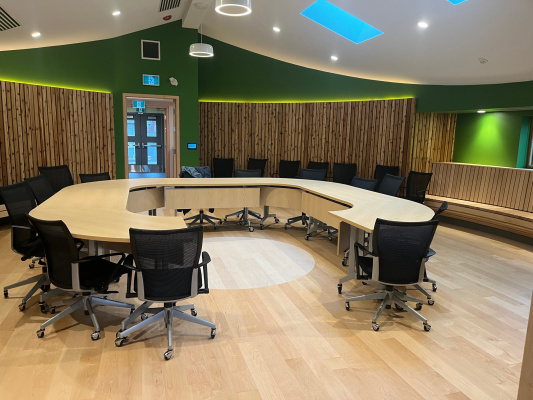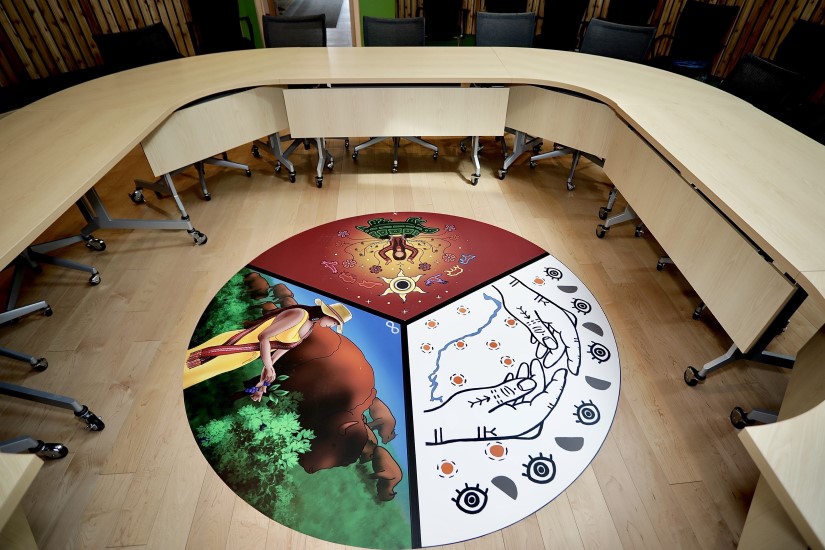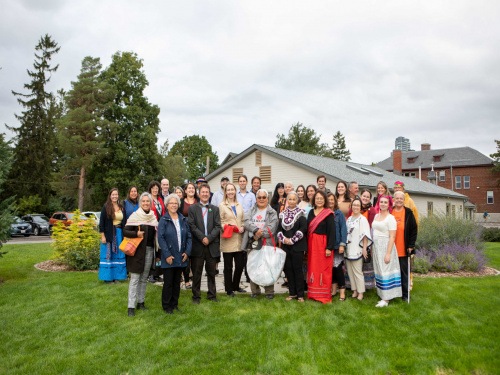The Mikinàk Ceremonial Lodge is an Indigenous gathering space located on the Central Experimental Farm in Ottawa. It is a place for Indigenous Agriculture and Agri-Food Canada (AAFC) employees and community members to come together, exchange ideas and perform traditional ceremonies.
It offers a teaching and learning environment that focuses on sharing Indigenous knowledge and lived experiences with Indigenous and non-Indigenous public servants. The Lodge also welcomes members of the public who wish to learn more about Indigenous cultures.
The Lodge is named “Mikinàk” (pronounced Mee-kee-nak), the Anishinaabe word for “turtle”, which is a sacred animal that represents “truth” to many Nations. In the context of the Mikinàk Lodge, which is located on Algonquin Anishinaabeg territory, the turtle carries the Anishinaabeg Grandfather Teaching of “Truth”. The Lodge is therefore a place where we speak about and acknowledge the “Truths” of our shared histories, which is a requirement of Reconciliation.
The Indigenous Network Circle (INC) at AAFC has spearheaded the making of the Lodge, with great support from other Indigenous employees and communities, as well as departmental officials.
“It’s a beginning point for something greater” — Orlando Blacksmith, INC co-chair.
Video transcript
[Inspirational music begins]
[Animated colourful hills appear along the bottom of the screen in the colours red, yellow, and dark blue. Each hill showcases a different pattern. Animate orange sun appears on the left side of the screen. Animated red feathers, a blue fire pit, and a yellow wagon appears amongst the hills. Red, blue and orange text appears on the screen.]
[Text on screen: Mikinàk Ceremonial Lodge]
[The title slowly fades away and several various Indigenous greetings pop up around the screen above the colourful animations.]
[The greetings vanish from the screen except one which appears in the middle of the screen. Welcome and Bienvenue appears on either side of the Indigenous greeting.]
[Orlando Blacksmith stands and talks to the camera. Orlando greets the viewers with an Indigenous greeting.]
Orlando Blacksmith: Hello. Welcome to the Mikinàk Lodge.
[Orlando opens the door of the ceremonial lodge. Cut to an aerial view of the lodge and a close-up view of the Indigenous Garden outside of the lodge.]
So, the Mikinàk Lodge is located directly on the Experimental Farm in Ottawa.
[An aerial view of the experimental farm in Ottawa. Cut to Orlando talking to the camera while standing in the lodge. On-screen text appears on the bottom right corner.]
[Text on screen: Orlando Blacksmith – Indigenous Student Advisor – Indigenous Support and Awareness Office – Agriculture and Agri-Food Canada]
Mikinàk in Anishinaabemowin does mean turtle. So in Algonquin culture, turtle can be a sign of wisdom or truth.
[A close-up view of wall art showcasing a woman standing and lifting her arms towards the sky and sun.]
[Annelind Jones appears on screen and talks to the camera. White on-screen text appears on the bottom right corner.]
[Text on screen: Annelind Jones – Indigenous Project Officer – Indigenous Support and Awareness Office – Agriculture and Agri-Food Canada]
Annelind Jones: The lodge has been open since September 2022.
[Together, employees talk and work on Indigenous activities at a round table in the ceremonial lodge.]
And it is open for Indigenous and non-Indigenous employees of Agriculture.
[Employees sit and stand around a meeting table as they listen to a speaker who is standing at the front of the meeting room.]
It's a space to come together and to, to practice reconciliation.
Depending on the day you come in you might hear some drumming, right.
[A close-up view of two men practicing smudging with sage at a table in the lodge.]
You might, um, smell the faint sage from the smudge or something like that.
[Orlando embraces the sage and smudging while he stands next to a colleague. Annelind stands and socializes with colleagues in the kitchen of the lodge. Cut to an overhead view of people sitting around a table and using Indigenous activities.]
And it's also open to other government departments too, and community organizations to come in as well.
[The camera moves towards Orlando as he sits at the front desk of the lodge.]
This place doubles as a workplace for our Indigenous co-workers.
[Colleagues working together around a table in the lodge.]
So it's like building a community within our department, right?
Like, I grew up on a little tiny reserve in North Quebec, right in the James Bay area, and so like, I grew up hunting and fishing, but I didn't have much opportunities to do cultural craft stuff.
[A close-up view of colleagues sit at a U-shape table and work on crafts together. Cut to a close-up view of two Indigenous beaded strips.]
So, it just feels empowering, I guess…
[A close-up view of Orlando sitting and working at the front desk.]
…because I can actually, on top of, you know, working 7.5 hours every day I get to actually participate in my own culture.
[The camera reveals Indigenous wall art and then moves back to reveal Orlando sitting at a table with a colleague as they handle kitchen ingredients.]
I have noticed that with the creation of the lodge…
[A colleague kneads dough into a small pie tray. Cut to Orlando kneeling at the oven and pulling out the pies that they made. A close-up view of Orlando removing the pies from their trays.]
…there's been a lot more interest in people coming to take these learning sessions, right?
[Annelind stands and talks to the camera.]
Even we've had Indigenous community members that that aren't public service workers…
[Cut to colleagues working around a table in a meeting room.]
…that come in for meetings and especially the feedback from elders and traditional knowledge keepers has been really awesome, which makes me just so happy.
[The camera quickly moves towards the Indigenous Garden and guides the viewer through the lodge to a large meeting room.]
Yeah, they've said that the space is welcoming. It's a nice place to meet, um, and especially that we have the ability to smudge in here.
[A close-up view of a colleague smudging.]
You don't have to be Indigenous.
[Orlando crosses his arms and stands in the middle of the Indigenous Garden with the lodge behind him.]
Your knowledge of Indigenous People can just be that you know they exist. That's fine. Your starting point can be at the very, very beginning. This place is open for anybody.
[Inspiring music ends.]
[Text on screen: Agriculture and Agri-Food Canada – Agriculture et Agroalimentaire Canada]
[Government of Canada wordmark]
[End]
Interior
The design of the Lodge combines cultural elements and art work of the 3 Indigenous groups: First Nations, Métis Nation and Inuit.
At the heart of the Lodge, is a large main gathering room for visitors to get together and connect as a community. This is also a dedicated space for smudging ceremonies and it is home to a Qulliq Oil Lamp, which is used by the Inuit Peoples to keep their homes warm.

This traditional tool is made out of soapstone and is fueled by blubber from seals and whales to burn wicks made out of arctic cotton grass.

Main gathering room (circular in shape).

About the artists
Live in Your Truth by Miskomin Twenish
Algonquin (First Nations)
Miskomin Twenish is a self-taught Algonquin artist from Kitigan Zibi. Her artistic journey started in 2015 and has been in love with creating ever since, she has been working primarily with Acrylic paint on canvas and digital illustration. Her artwork is heavily influenced by Traditional Woodlands style which usually involves line work, animals, flowers and can also be inspired by her culture/traditions as well as ongoing Indigenous issues/movements.
This artwork was created to represent living in your truth and how important it is to embrace it. In our teachings, the turtle carries truth. Truth is one of the 7 grandfather teachings. When you are living in your truth, you also live by the other grandfather teachings because they are connected and one cannot exist without the other. By doing so, it will allow you to flourish inward and outward because you are honest with yourself.
Untitled by Gayle Uyagaqi-Kabloona
Inuk
Gayle is a multidisciplinary artist and writer from Ottawa, ON, who creates ceramics, prints, graphic art, wall-hangings, knitwear and more. Gayle’s work is inspired by the art of her grandmother, Victoria Mamnguqsualuk, and the colours and bold shapes of her great-grandmother, Jessie Oonark, and often incorporates traditional Inuit stories told through a modern, feminist lens
“I used the Inuit views on knowledge transfer in my graphic: observation, learning by doing, traditional tools (qulliq) with a river from my homeland to represent skill acquisition and knowledge of environment. The little dots are representative of people and they're "sewn" in, which is another skill that is learned by being together.”
Coexisting in Harmony by JD Hawk
Metis
JD was born and raised in Winnipeg, MB. JD specializes in oil paintings. His artwork reflects his love of the outdoors, people and connection to his Métis heritage. He has been commissioned nationally and internationally, with collectors worldwide, including Parks Canada, Canada Games 2022, and the Manitoba Métis Federation.
“It was important for me to show peace and harmony that come with taking care of our plants and animals. The blue sky represents water. The yellow dress represents the sun. In between, we have the land and animals we must take care of. The bison is facing East as a reminder that is where the storm (colonization) came from and we persevered. The Sash is not just a decorative piece, it was used as a tool. The colour tells a story of the journey the Métis people have been on. The hat is a symbol of protecting the knowledge that comes with being responsible. The infinity symbol is that of two cultures coming together to create one.”
Exterior
The Healing Garden surrounds the Mikinàk Ceremonial Lodge. This garden, which will take a few years to complete, will be home to traditional medicines such as sage, cedar, sweetgrass, willow fungus and other traditional medicines for users’ personal or ceremonial use.

INC and Indigenous community members during the inauguration of the Mikinàk Ceremonial Lodge in September 2022.

Close up of the garden
Contact
For more information on the Mikinàk Ceremonial Lodge, to book a tour or to request guidance on hosting an Indigenous learning activity, please contact the Indigenous Support and Awareness Office at aafc.isao-bssa.aac@agr.gc.ca.
Features

An important step towards reconciliation